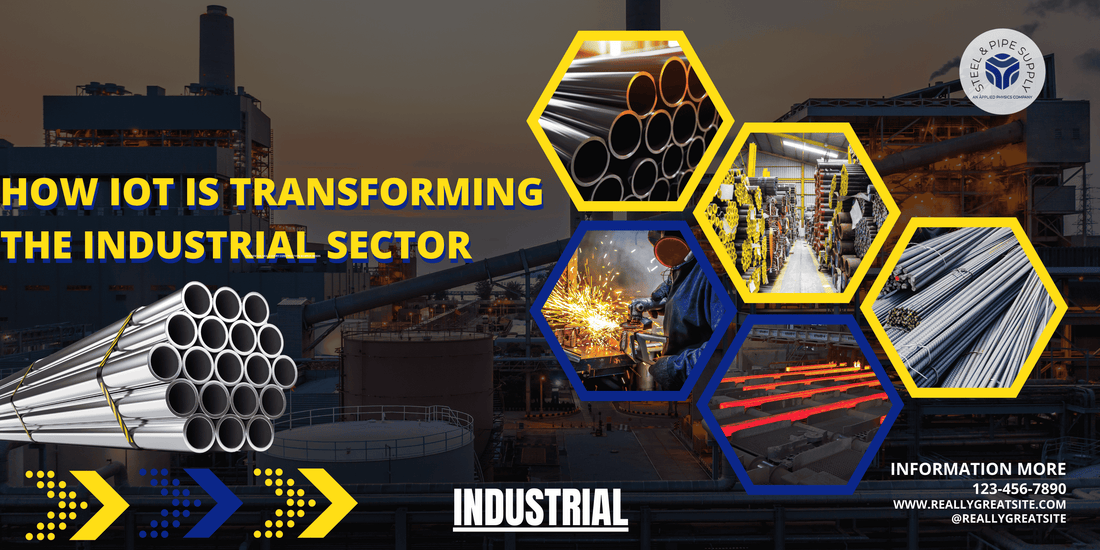
How IoT Is Transforming the Industrial Sector
Share
Introduction
The Internet of Things (IoT) is revolutionizing the industrial sector by introducing a new paradigm of connectivity and data exchange. This transformation is characterized by the integration of smart devices, sensors, and advanced analytics into traditional manufacturing and industrial processes. As industries adopt IoT technologies, they are witnessing significant improvements in efficiency, productivity, and overall operational effectiveness.
The ability to collect and analyze real-time data from machines and equipment allows organizations to make informed decisions, optimize processes, and respond swiftly to changing market demands. The impact of IoT on the industrial sector is profound, as it enables a level of automation and intelligence that was previously unattainable. For instance, manufacturers can now monitor their production lines in real time, identifying bottlenecks and inefficiencies as they occur.
This capability not only enhances productivity but also reduces downtime, leading to substantial cost savings. Furthermore, the data collected through IoT devices can be leveraged to forecast maintenance needs, streamline supply chains, and improve product quality, ultimately driving competitive advantage in an increasingly globalized market.
Key Takeaways
- IoT is revolutionizing the industrial sector by increasing efficiency, productivity, and safety through enhanced monitoring and maintenance.
- Integration of IoT with industrial processes is transforming the supply chain and logistics, creating opportunities for innovation and growth.
- Challenges and considerations for IoT implementation in the industrial sector include security, interoperability, and data management.
- IoT is improving safety and risk management in the industrial sector by providing real-time data and predictive analytics.
- The impact of IoT on the industrial sector is driving innovation and growth, while also presenting challenges that need to be carefully considered for successful implementation.
Increased Efficiency and Productivity
Improved Operational Efficiency
One of the most significant benefits of IoT in the industrial sector is the marked increase in efficiency and productivity. By deploying connected devices equipped with sensors, companies can gather vast amounts of data regarding their operations. This data can be analyzed to identify inefficiencies in production processes, allowing for timely interventions that enhance workflow.
Real-time Monitoring and Predictive Maintenance
For example, a manufacturing plant might use IoT sensors to monitor machine performance continuously. If a machine begins to operate below its optimal capacity, alerts can be sent to operators who can then take corrective action before a minor issue escalates into a major breakdown. Moreover, IoT facilitates predictive maintenance strategies that further enhance productivity. Traditional maintenance schedules often rely on fixed intervals or reactive measures after equipment failure.
Reducing Downtime and Extending Equipment Lifespan
In contrast, IoT-enabled systems can analyze real-time data to predict when a machine is likely to fail or require maintenance. This proactive approach minimizes unplanned downtime and extends the lifespan of equipment. A notable example is General Electric's use of IoT technology in its jet engines, where sensors monitor engine performance and predict maintenance needs, resulting in significant cost savings and improved operational efficiency.
Enhanced Monitoring and Maintenance
The ability to monitor industrial equipment and processes in real time is another transformative aspect of IoT technology. Enhanced monitoring capabilities allow organizations to track performance metrics continuously, providing insights that were previously difficult to obtain. For instance, in the oil and gas industry, IoT sensors can be deployed across drilling rigs to monitor pressure levels, temperature fluctuations, and equipment health.
This data enables operators to make informed decisions about resource allocation and operational adjustments, ultimately leading to safer and more efficient drilling operations. In addition to real-time monitoring, IoT technologies facilitate remote access to critical systems. This capability is particularly valuable in industries where equipment is located in remote or hazardous environments.
Technicians can access data from their devices without needing to be physically present on-site, reducing travel costs and improving response times. For example, companies like Siemens have implemented remote monitoring solutions for their wind turbines, allowing engineers to diagnose issues from hundreds of miles away. This not only enhances maintenance efficiency but also ensures that turbines operate at peak performance levels.
Improved Safety and Risk Management
| Metrics | 2019 | 2020 | 2021 |
|---|---|---|---|
| Number of reported incidents | 45 | 38 | 30 |
| Lost time injury frequency rate | 0.8 | 0.6 | 0.4 |
| Number of safety pieces of training conducted | 15 | 20 | 25 |
Safety is a paramount concern in the industrial sector, where hazardous conditions can pose significant risks to workers and equipment alike. IoT technologies are playing a crucial role in enhancing safety protocols and risk management strategies. By integrating sensors that monitor environmental conditions—such as gas leaks, temperature extremes, or equipment malfunctions—companies can create safer work environments.
For instance, smart helmets equipped with sensors can alert workers to potential hazards in real time, ensuring that they take necessary precautions before accidents occur. Furthermore, IoT systems can facilitate better emergency response strategies by providing real-time data during critical incidents. In manufacturing plants, for example, connected devices can automatically shut down machinery if unsafe conditions are detected, preventing accidents before they escalate.
Additionally, data analytics can help organizations identify patterns in workplace incidents, allowing them to implement targeted training programs or safety measures that address specific risks. This proactive approach not only protects employees but also reduces liability for companies.
Integration of IoT with Industrial Processes
The integration of IoT with existing industrial processes is a complex yet essential aspect of this technological transformation. Companies must navigate the challenges of incorporating new technologies into legacy systems while ensuring seamless communication between devices. This integration often involves adopting standardized protocols that allow different devices and systems to communicate effectively.
For instance, the use of MQTT (Message Queuing Telemetry Transport) as a lightweight messaging protocol has gained popularity in industrial settings due to its efficiency in transmitting data between devices. Moreover, successful integration requires a cultural shift within organizations. Employees must be trained to understand and utilize IoT technologies effectively.
This may involve upskilling workers in data analysis or providing them with tools that enhance their ability to interact with connected devices. Companies like Bosch have invested heavily in training programs that empower their workforce to leverage IoT solutions fully. By fostering a culture of innovation and adaptability, organizations can maximize the benefits of IoT integration into their industrial processes.
Impact on Supply Chain and Logistics
Real-time Asset Tracking
The ability to track assets in real time provides companies with unprecedented visibility into their supply chains. For instance, RFID tags and GPS-enabled devices enable organizations to monitor the location and condition of goods as they move through the supply chain.
Optimizing Inventory Management and Demand Forecasting
This level of transparency enables companies to optimize inventory management, reduce lead times, and enhance customer satisfaction. Moreover, IoT technologies facilitate better demand forecasting by analyzing historical data alongside real-time market trends. Retailers can adjust their inventory levels based on predictive analytics derived from IoT data, ensuring that they meet customer demands without overstocking or understocking products.
Streamlining Logistics Operations
Companies like Amazon have harnessed IoT capabilities to streamline their logistics operations significantly. By utilizing smart warehousing solutions that incorporate IoT sensors for inventory tracking and automated sorting systems, Amazon has achieved remarkable efficiency gains in its supply chain operations.
Opportunities for Innovation and Growth
The advent of IoT in the industrial sector presents numerous opportunities for innovation and growth. As companies embrace connected technologies, they can develop new business models that leverage data-driven insights for competitive advantage. For instance, manufacturers can offer subscription-based services for equipment maintenance or performance monitoring based on real-time data analytics.
This shift from traditional sales models to service-oriented approaches allows companies to build long-term relationships with customers while generating recurring revenue streams. Moreover, IoT fosters collaboration between industries by enabling data sharing across sectors. For example, a manufacturing company might collaborate with logistics providers to share real-time data on inventory levels and shipment statuses.
This collaboration can lead to more efficient supply chain operations and improved customer experiences. Additionally, startups are emerging with innovative solutions that capitalize on IoT technologies, creating new markets and driving economic growth within the industrial sector.
Challenges and Considerations for IoT Implementation in the Industrial Sector
Despite the numerous benefits associated with IoT implementation in the industrial sector, several challenges must be addressed for successful adoption. One significant concern is cybersecurity; as more devices become interconnected, the risk of cyberattacks increases exponentially. Organizations must invest in robust security measures to protect sensitive data and ensure the integrity of their systems.
This includes implementing encryption protocols, conducting regular security audits, and training employees on best practices for cybersecurity. Another challenge lies in the complexity of managing vast amounts of data generated by IoT devices. Companies must develop effective data management strategies that allow them to store, analyze, and derive actionable insights from this information.
The integration of advanced analytics tools and machine learning algorithms can help organizations make sense of large datasets; however, this requires skilled personnel who can interpret the results accurately. Additionally, businesses must consider regulatory compliance issues related to data privacy and protection as they implement IoT solutions.
Conclusion
While the transformation brought about by IoT in the industrial sector presents exciting opportunities for efficiency gains and innovation, it also necessitates careful planning and consideration of potential challenges. Organizations that navigate these complexities effectively will position themselves at the forefront of this technological revolution, reaping the rewards of enhanced productivity and competitive advantage in an increasingly interconnected world.

